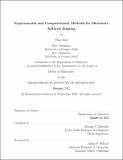Experimental and Computational Methods for Shortwave Infrared Imaging
Author(s)
Saif, Mari
DownloadThesis PDF (377.5Mb)
Advisor
Bawendi, Moungo G.
Terms of use
Metadata
Show full item recordAbstract
Optical imaging methods help researchers interrogate complex biological and medical processes with the use of optical light, usually in the visible region (400-700 nm). We explore visualizing the state of liver diseases in living mice using non-invasive near infrared (NIR, 700-900 nm) and shortwave infrared (SWIR, 900-1700 nm) autofluorescence imaging. NIR/ SWIR imaging makes use of recently developed, high-sensitivity cameras, and relatively low en-ergy NIR excitation, which is less destructive to and penetrates deeper through biological tissue than conventional ultraviolet or visible light. Detecting longer NIR/ SWIR autoflu-orescence emission takes advantage of both the maximal transparency of biological tissue at these wavelengths, and could also enable greater specificity to disease associated signal, as there are very few autofluorescent materials from healthy tissue samples at these wave-lengths. We extend the imaging techniques with incorporation of background and shading correction methods from a suite of computer vision methods to determine autofluorescence signal levels in brain tissue, which consists of highly complex varying cellular types, helping us understand the applicability of our imaging techniques with advanced methods of im-age processing. In addition, we further investigate immunofluorescence methods with the incorporation of NIR/SWIR autofluorescence as a lipofuscin specific channel to digitally re-move autofluorescence from multi-fluorophore immuno-stained mouse liver samples. We also explore color deconvolution in histopathology imaging, and develop algorithms to support automated thresholding and segmentation for more accurate autofluorescence quantification. We show the development of NIR/SWIR experimental methods and computer vision processes to achieve a better understanding of extending NIR/SWIR imaging in pre-clinical and clinical settings for studying disease progression and regression.
Date issued
2022-02Department
Massachusetts Institute of Technology. Department of ChemistryPublisher
Massachusetts Institute of Technology